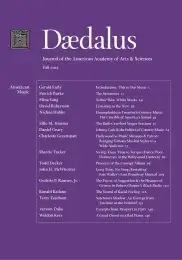The Sound of Racial Feeling
Critics continue to debate the value of U.S. black music according to a flawed distinction between racial authenticity and social construction. Both sides have it half-right. Black music's value arose historically as the result of a fundamental contradiction in the logic of race tracing back to the slave era. As “Negro” in form, the music was constituted as the collective property of another property, a property-in-slaves. The incongruity produced a perception of black music as an auditory form embodied with fleshly substance, and this sense of racial feeling would live on despite its inconsistencies with modern ideas about race.
The feel of the body, the sensation of flesh, is never very far from the sound of black music. This quality of embodiment–of animated sound waves working affectively to link person to person–sits at the very heart of its aesthetic value. Listeners often describe U.S. black music as if there were a common sentience, or even a human presence, in its audible makeup. This condition is most obvious in vocal renditions, but particularly revealing are those circumstances in which there is no singer singing, or in which voice represents but one aspect of a larger expression. For example, listeners frequently comment that a particular instrumentalist’s tone sounds warm, angry, intimate, or sensuous, to the point of granting that player’s timbre and embouchure qualities of emotion. Jazz lovers, moreover, have long compared improvisations to acts of storytelling, recognizing greatness in musical tales that seem to fuse sound with the personality of the artists who play them.
Yet another line of thinking identifies the physicality of black music in its historical associations with dance, a linkage that traces back to early modern styles such as the cakewalk and ragtime. It would be hard to fathom James Brown’s recording of Cold Sweat without also calling to mind the . . .
